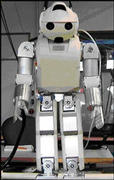Custom
Conflicting Signals Can Confuse Rescue Robots
A NIST analysis of wireless radio field trials for US&R robots, presented at a conference on February 28,* found that 10 out of the 14 robots tested experienced communication problems due to radio interference from other systems. Engineers carried out tests on the robots last August at a US&R robot standards development gathering in Gaithersburg, Md., sponsored by the Department of Homeland Security. The researchers found that neither use of "industrial, scientific, and medical" (ISM) frequency bands nor adherence to protocols designed to minimize interference between systems in the bands could guarantee flawless communication between a robot and its human operator.
Radio interference could happen whenever the ISM frequency bands became crowded or when one user had a much higher output power than the others. An example of the latter problem occurred during the tests when transmitters in the 1760 MHz band knocked out video links in the 2.4 GHz frequency band. In another case, a robot using an 802.11b signal in the 2.4 GHz band overwhelmed and cut off a robot that had been transmitting an analog video link at 2.414 GHz.
The NIST paper lists a number of ways to improve urban search and rescue wireless communications. Options, some of which are currently being investigated by robot manufacturers, include changes in frequency coordination, transmission protocols, power output, access priority, and using relay transformers to increase the range of wireless transmissions (a technique known as multi-hop communications). The paper also suggests establishing new access schemes or software-defined radios that allow interoperable communications.
The August 2006 US&R DHS/NIST robot exercise at the Montgomery County Fire Academy in Gaithersburg offered emergency responders an opportunity to deploy robots in realistic training scenarios as well as helped robot developers and manufacturers refine designs and better understand performance requirements. The work is funded by DHS's Science and Technology Directorate through NIST's Office of Law Enforcement Standards.
* K.A. Remley, G. Koepke, E. Messina, A. Jacoff and G. Hough. Standards development for wireless communications for urban search and rescue robots. 9th Annual International Symposium on Advanced Radio Technologies, Feb. 26--28, 2007, Boulder, Colo.
Note: This story has been adapted from a news release issued by National Institute of Standards and Technology.
Second Humanoid Robot In France Welcomed
Research activities in the field of human robotics are expanding rapidly. The establishment of the JRL (Joint Japanese-French Robotics Laboratory) based in both Japan (Tsukuba) and France (Toulouse-LAAS and Montpellier-LIRMM) contributed strongly to the realization, reinforcement and dynamization of the robotics research community in this field. The two humanoid robots are at the core of JRL's research.
The acquisition of HOAP3 by LIRMM, 50% co-financed by the CNRS, is part of this process. Within the framework of JRL-France, the LIRMM will thus offer the national community an open experimental platform for the validation of models or control methods contributing to ambulation and the handling of objects while maintaining balance.
Insert Another Sub Header Here
This 8.8 kg, 60 cm tall robot has 28 motorized articulations. It has a large number of sensors including accelerometers, rate gyros, an infra-red range finder, pressure sensors and two cameras. This unit is based around a completely open software platform (RTLinux) allowing all of the researchers interested to freely evaluate and test their new theoretical developments concerning the modeling, control, vision or learning of these.
This platform supplements the one already installed at LAAS in Toulouse, the HRP2 robot, which is more realistic because it is on a "human scale," but also more complex. HOAP3 will allow for very rapid progress because its use is simple and does not require prior validations on a simulator. Furthermore, the software platform used to control the robot will facilitate the integration and the harnessing of work already developed with Linux.
On the other hand, the fact that HOAP3 is small means that it cannot perform all of the tasks that a humanoid robot might do in a life-size environment. For these tests, the platform installed at LAAS will thus be complementary. Lastly, HOAP3 has a wireless communication link that allows it to handle teleoperation work or collaboration of mobile robots. One of LIRMM's hopes is to soon have several humanoids so that it can study robot cooperation.
You can discover HOAP3 at the National Humanoid Robotics Exhibition to be held in Montpellier on March 29 and 30, 2007 (http://www.lirmm.fr/JNRH).
